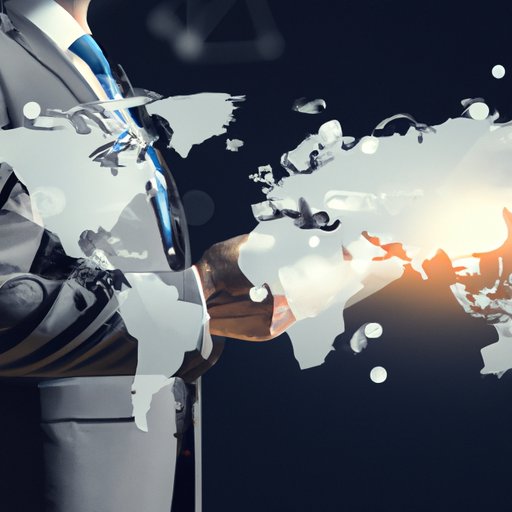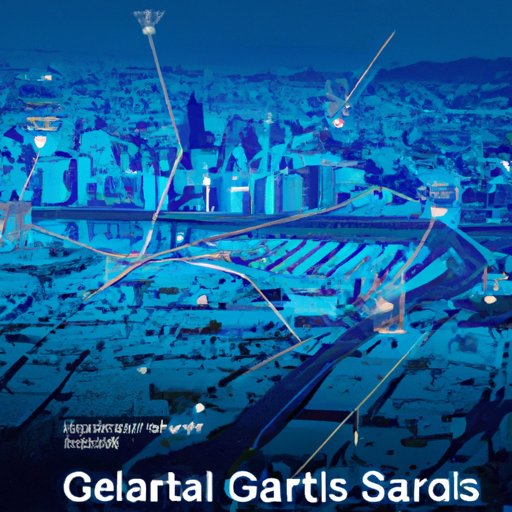Introduction
Geospatial technology is a rapidly advancing field that is transforming the way we live and work. It combines a range of technologies such as mapping, remote sensing, global positioning systems (GPS), geographic information systems (GIS), and analytics to capture, store, analyze, and visualize data about our physical world. This technology has the potential to revolutionize how businesses operate, how governments plan for their citizens, and how disasters are managed.

Exploring the Benefits of Geospatial Technology
The use of geospatial technology is growing rapidly, with many organizations discovering its potential to streamline processes and improve efficiency. Here are some of the key benefits of geospatial technology:
Improved Efficiency and Accuracy in Businesses
Geospatial technology can help businesses improve their operational efficiency by automating the collection of data, streamlining processes, and providing real-time analysis of data. This helps businesses make more informed decisions and reduces errors due to human error. According to a study by MarketsandMarkets, the global geospatial market is expected to grow from USD 299.1 billion in 2020 to USD 618.0 billion by 2025, at a compound annual growth rate of 15.3%.
Enhanced Decision Making for Smart Cities
Smart cities are leveraging geospatial technology to make more informed decisions about urban planning, transportation, energy usage, and other aspects of city life. By integrating sensors and devices, intelligent monitoring and control systems can be implemented to track and manage resources in real time. Additionally, predictive analytics can be used to anticipate future trends and plan accordingly.
More Effective Disaster Management
Geospatial technology is being used to improve disaster risk assessment, response times, and mapping of affected areas. By providing real-time data on the location and severity of disasters, geospatial technology enables emergency responders to quickly identify and respond to crises. According to a study published in the International Journal of Disaster Risk Reduction, the use of geospatial technology can significantly reduce the impact of disasters.
Facilitated Environmental Conservation
Geospatial technology can be used to monitor water quality, track endangered species, and preserve natural resources. For example, GIS can be used to map areas of deforestation and identify areas most at risk of destruction. This data can then be used to inform conservation efforts and create sustainable development plans.

How Geospatial Technology is Revolutionizing Businesses
Businesses are increasingly turning to geospatial technology to automate data collection, streamline processes, and gain real-time insights into their operations. Here are some of the ways in which geospatial technology is revolutionizing businesses:
Automation of Data Collection
Geospatial technology can be used to automate the collection of data from various sources, such as satellite imagery, aerial photography, and GPS devices. This data can then be stored and analyzed to provide valuable insights into customer behavior, market trends, and other business metrics.
Streamlining of Processes
Geospatial technology can also be used to streamline internal processes, such as inventory tracking, asset management, and route optimization. By combining geospatial data with other sources of data, businesses can gain a comprehensive view of their operations and identify opportunities for improvement.
Real-Time Analysis of Data
Geospatial technology can also be used to analyze data in real time, enabling businesses to respond quickly to changing market conditions. This allows businesses to make faster, more informed decisions and stay ahead of the competition.
What is Geospatial Technology and How it Works?
Geospatial technology is a combination of hardware, software, and data that is used to capture, store, analyze, and visualize geographic data. It consists of several components, including satellites, imaging systems, GPS receivers, GIS software, and databases.
The process of using geospatial technology begins with data collection. Satellite imagery, aerial photography, and GPS devices are used to collect data about the physical environment. This data is then stored in a database and analyzed using GIS software. The resulting maps and visualizations can then be used for a variety of purposes, such as urban planning, resource management, and route optimization.

The Power of Geospatial Technology in Smart Cities
Smart cities are leveraging geospatial technology to create intelligent systems that can monitor and control infrastructure and services in real time. By integrating sensors and devices, smart cities can collect data on traffic patterns, energy consumption, and other factors that affect city life. This data can then be analyzed to identify inefficiencies and develop strategies for addressing them.
Furthermore, predictive analytics can be used to anticipate future trends and plan accordingly. For example, cities can use geospatial data to plan new transportation routes and optimize existing ones. This helps reduce congestion and improve air quality.
Geospatial Technology for Disaster Management
Geospatial technology is being used to improve disaster management by providing real-time data on the location and severity of disasters. This data can be used to identify affected areas, assess risks, and deploy emergency personnel more quickly and accurately. Additionally, geospatial data can be used to create detailed maps of affected areas, enabling responders to locate survivors and access supplies more easily.
Using Geospatial Technology to Enhance Environmental Conservation
Geospatial technology is also being used to monitor water quality, track endangered species, and preserve natural resources. For example, GIS can be used to map areas of deforestation and identify areas most at risk of destruction. This data can then be used to inform conservation efforts and create sustainable development plans.
Conclusion
Geospatial technology is a rapidly evolving field that is revolutionizing industries and societies. From improved efficiency and accuracy in businesses to enhanced decision making for smart cities, geospatial technology is transforming the way we live and work. It is also being used to facilitate disaster management and environmental conservation. As the technology continues to advance, its potential applications will only continue to increase.
(Note: Is this article not meeting your expectations? Do you have knowledge or insights to share? Unlock new opportunities and expand your reach by joining our authors team. Click Registration to join us and share your expertise with our readers.)
